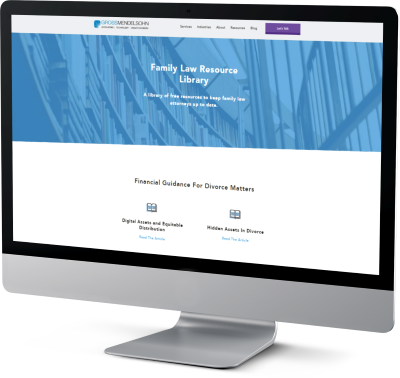As a matrimonial attorney, you know better than anyone that divorce can bring out the worst in people. Despite their best efforts to work amicably, divorcing husbands and wives often end up being less than forthcoming.
In some cases, one spouse has been planning the divorce for a while. They might have tried to hide or divert assets and/or earnings from the other spouse in an effort to decrease the marital assets or minimize their earnings. This, in turn, would reduce the amount of alimony or child support they may have to pay.
Determining a spouse’s assets and earnings is not always an easy task. It gets even more complicated when one or both of the spouses owns a business.
Forensic accountants are sometimes called in to prepare an income determination calculation for a business owning spouse or both spouses. When one spouse owns and controls a business, there is considerable opportunity for them to intermingle business and personal expenses. In addition, they may have created various income streams that the other spouse might not be aware of.
Some common examples of income components that may be manipulated, as well as personal expenses paid by a business, include:
-
Distributions charged as loans
-
Payroll to other family members or friends
-
Automobile expenses
-
Cell phone expenses
-
Vacations disguised as company travel
-
Home improvements and/or maintenance
-
Non-business related professional fees, such as divorce fees or other personal matters
-
Household employees
-
Shopping and/or gifts
-
Personal life insurance
-
Cash
-
Double counting expenses
A Case of Misstated Income
We were recently engaged by the divorce attorney for “Mr. Smith” to analyze the estimated income of “Mrs. Smith,” a real estate agent in Virginia.
According to Schedule C of Mrs. Smith’s tax return, she claimed that her income from her real estate business was approximately $95,000. Mr. Smith believed that Mrs. Smith artificially lowered her income so he would be responsible for alimony payments.
After Gross Mendelsohn was engaged, we first examined the gross profit margin (income as a percentage of gross receipts) for a five-year period. While the gross profit margin had reached a high of 80% in Year 2 of that period, it was only 30% for Year 5 of the same period. This big variance was a red flag.
We then requested and received documents from Mrs. Smith supporting the claimed income and expenses for Year 5 (with the dip in gross profit margin). From this, we were able to isolate what we believed to be significant personal non-business expenses and discovered some manipulation/overstatement of expenses.
During our analysis of the documents provided, we noted numerous transactions showing what appeared to be cash withdrawals via either an ATM or as cash back as part of another transaction. These withdrawals, totaling approximately $3,000, were undocumented; therefore, we were unable to substantiate them as valid business expenses.
In addition, we noted a significant number of questionable expenses either charged on a corporate credit card or paid for with a business check. Based on our review of the charges and canceled checks, we identified approximately $74,000 in questionable expenses. These included payments by the business for items such as:
-
Distributions charged as loans
-
Payroll to other family members or friends
-
Automobile expenses
-
Cell phone expenses
-
Vacations disguised as company travel
-
Home improvements and/or maintenance
-
Non-business related professional fees, such as divorce fees or other personal matters
-
Household employees
-
Shopping and/or gifts
-
Personal life insurance
-
Cash
-
Double counting expenses
While on the surface it might seem like expenses labeled as “professional fees,” “wages” and “repairs and maintenance” are normal expenses for a real estate agent, we dug deeper to find that none of these expenses were related to Mrs. Smith’s real estate business. Therefore, they should not have been deducted on her tax return when determining her income.
We also noted that Mrs. Smith’s Schedule C from her tax return was prepared on the cash method of accounting, meaning that expenses are deducted in the year they are actually paid. According to the supporting documentation provided, Mrs. Smith claimed approximately $44,000 in home staging expenses, although we were only able to identify $12,000 in payments. As a result, this expense was overstated by approximately $32,000.
Finally, Mrs. Smith deducted expenses twice in some cases on her Schedule C, once supported by the original invoice and a second time supported by a canceled check for the same invoice.
Results of the Case
After our analysis was completed, we concluded that Mrs. Smith’s actual income was not $95,000 as she had reported on Schedule C of her tax return, but that it was closer to $225,000.
We submitted an expert's report to Mr. Smith’s attorney and one of our forensic accountants testified about our findings during the divorce proceedings. In the end, the judge agreed with our assessment and determined that Mrs. Smith’s income should have been $225,000. As a result, Mr. Smith was awarded alimony, potentially saving him tens of thousands of dollars had he just accepted his former wife’s income claim.
Need Help?
Our Forensic, Valuation & Litigation Support Group can help. Contact us online or call 800.899.4623.


